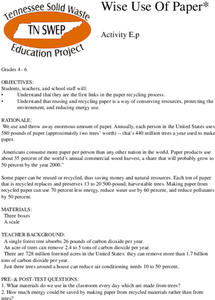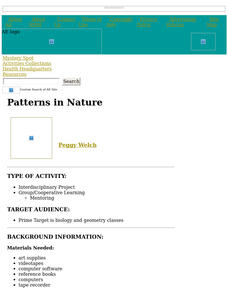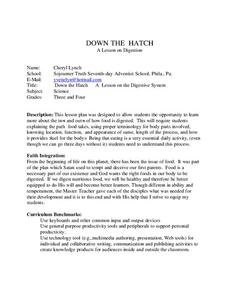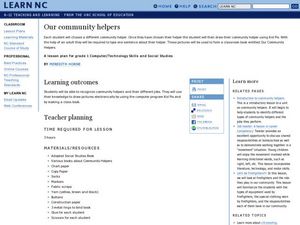Curated OER
Stargazers and Skywatchers
Students observe the daily motions of the sun and relate them to the functions of a sundial. They determine the locations of sunrises and sunsets and determine how the elevation of the sun effects temperature.
Curated OER
Laparoscopy Tissue Biopsy
Students describe the anatomy and physiology of a selected organ. They identify the major artery and vein that delivers blood to and from the selected organ and construct an accurate scaled 3D model of a selected organ.
Curated OER
Wise Use of Paper
Students explore the paper recycling process. They experiment with ways to conserve and recycle paper products.
Curated OER
Glaciers and Ice Wedging
Fourth graders observe buckling sidewalks and potholes before attempting to determine how these things are caused. They freeze water filled plastic cups that have been covered. As the water freezes, the students observe what happens to...
Curated OER
Can Diseases be Prevented?
Students write a research paper on a disease based on their internet or library research. They are asked to create a Public Service Announcement. Students must comprehend as much as possible about diseases that have affected society in...
Curated OER
Air Pollution: A Local and Global Problem
Students work together to solve the problem of air pollution. Using the Internet, they research the pollution problem in one city. Using the data, they develop their own solution and pitch it to the class. They must identify the...
Curated OER
The Seasons
Students determine the effect of the earth's tilt on the amount of incoming solar radiation throughout the year. They simulate the earth's orbit around the sun using a light bulb and a globe to simulate the seasons. Assessment questions...
Curated OER
Retrograde Motion
Students study the motions of the heavenly bodies. In this space lesson plan students use models to show a variety of schemes explaining the motions.
Curated OER
Didgeridoo
In this didgeridoo, students read 2 legends about didgeridoos and write 3 facts, draw what one may look like and then view a real picture of a didgeridoo. Websites referred to are not given.
Curated OER
Number Line Mathematics
Students translate problem situations into diagrams, models, and numerals using whole numbers, fractions, mixed numbers, decimals, and percents. They identify that numbers in different forms are equivalent or not equivalent using whole...
Curated OER
Delayed Gratification
Word problems are great for engaging critical thinking skills, and word problems involving money increase a child's financial literacy. Boost your critical and financial thinkers with a multi-step word problem involving money and problem...
Curated OER
Light and Dark
Students explore the concept of light and dark. In this light sources lesson, students use an interactive whiteboard to discuss light sources and illumination. The students complete a worksheet as an assessment.
Curated OER
Past Simple English Exercises
In this past simple verb tense online activity, students unscramble verbs and place the past simple form in each of 20 sentences. They match 8 sentences to the clip art pictures and write the sentence number in the box. They submit the...
Curated OER
Patterns in Nature
Research patterns in nature which illustrate biological and mathematical concepts. Your class will discover and explore aspects of fractals, Fibonaccis numbers, whale and butterfly migration patterns, whale identification, flower...
California Polytechnic State University
Australian Geography Unit
At the heart of this resource is a beautifully detailed PowerPoint presentation (provided in PDF form) on the overall physical geography of Australia, basic facts about the country, Aboriginal history, and Australia culture and lifestyle.
Google
Create Your Own Google Logo
You'll have oodles of Google Doodles. Scholars create their own Google logos using the Scratch coding program. After watching videos on how to add blocks of code in Scratch, they use their newfound knowledge to design a logo based on a...
Teach Engineering
Exploring Capillary Action
Explore capillary action from different perspectives. In the fourth installment of a nine-part series, scholars perform several experiments to observe capillary action. They look at the meniscus of water in a glass, observe capillary...
Curated OER
Pilgrims and Puritans
With graphic organizers galore, learners will follow the changes of church and state in early colonial America. They look at the differences between the pilgrims and the puritans in terms of beliefs and life ways. Myths and...
Curated OER
A Place in Time
Students become familiar with an eruptive history and related world events and impart a sense of the immensity of geological time. They explore timelines by creating their own, then are introduced to major eruptive periods of Mount St....
Curated OER
Interest Calculation and Spreadsheets
Students, while in the computer lab working on a spreadsheet program, calculate interest and accumulated value of a savings plan. They follow specific directives on how to create their spreadsheets. At the end of the lesson plan they...
Curated OER
Down The Hatch
Students investigate how food is digested. They go through the terminology of the digestive system and follow the steps to it from beginning to end. Students use technology tools to create presentations to illustrate the functions of the...
Curated OER
"Our Community Helpers"
Young scholars define the term community. They list many, varied, and unusual jobs (careers) that people might have in our Communities. Students identify the purpose of the work done by their parents-either in the home, or outside of the...
Curated OER
Water Cycle: Weather Lesson 1
First graders go on a water walk, collect weather data, and measure rainfall for a month. They examine the water cycle in this series of lessons.
American Psychological Association
Activities from the Society for the History of Psychology Website
The Society for the History of Psychology provides a list of teaching activities designed to acquaint learners with the various fields of psychology and introduce them to prominent psychologists. Details for several of the activities are...

























